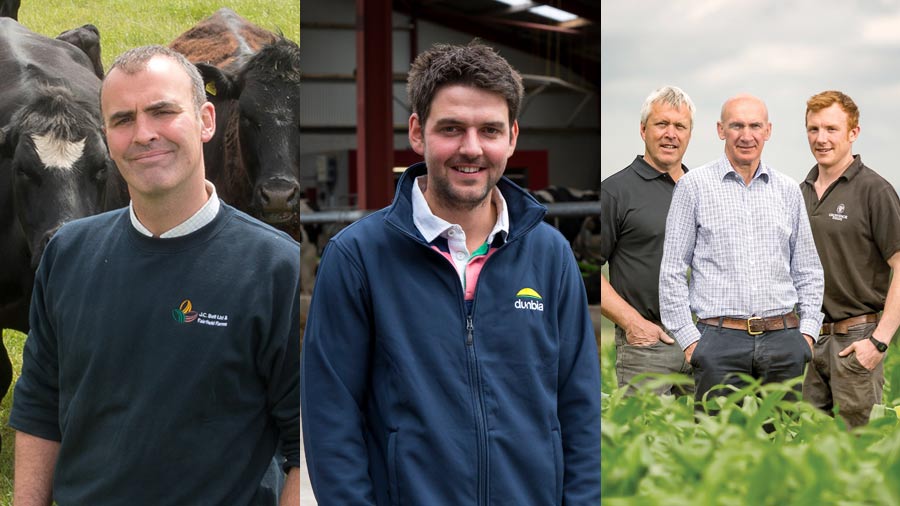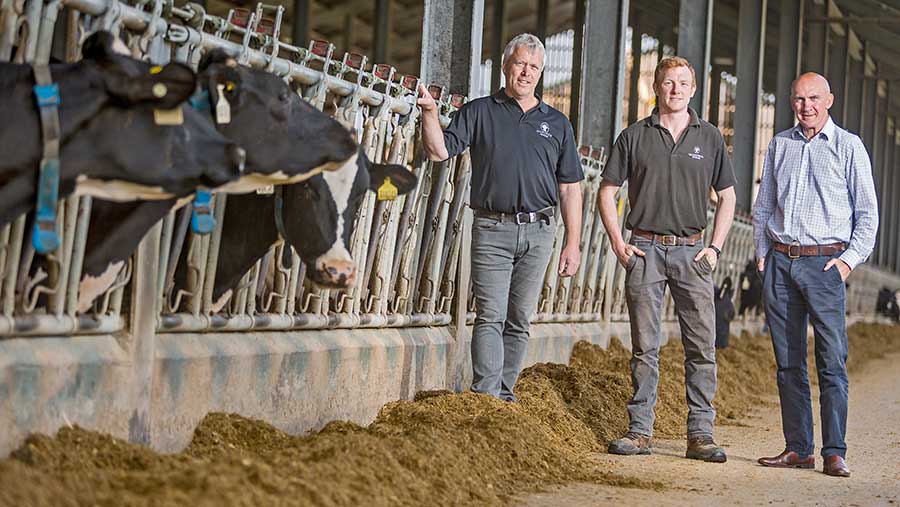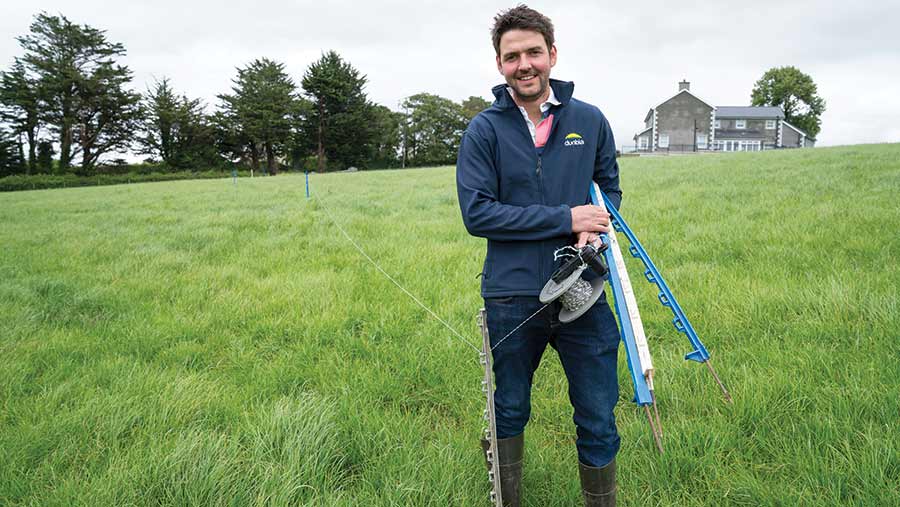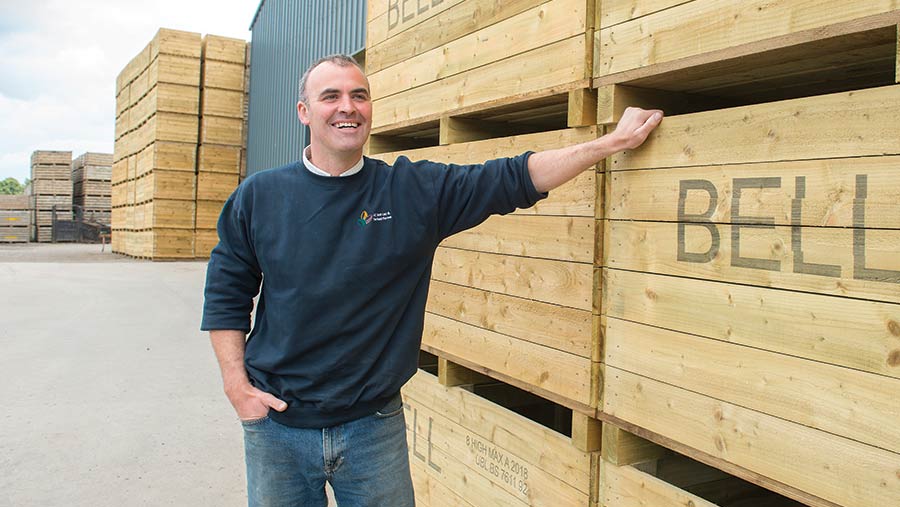Farmers Weekly Awards – Mixed Farmer finalists 2018

What does it take to be the best at running multiple enterprises that are profitable and complementary?
Our three finalists each think they have the answer, tackling challenges in their area in exciting and forward-thinking ways.
The 2018 Farmers Weekly Mixed Farmer finalists and judges
The finalists:
- Grosvenor Farms, Aldford, Cheshire
- Matthew Brownlee, Loughgall, Armagh
- David Bell, Fairfield Farm, Colinsburgh, Fife
The judges:
- Robert Neill, last year’s winner
- Andrew Meredith, Farmers Weekly deputy business editor
- Matthew Curry, Strutt & Parker senior associate director and head of farming, Morpeth office
See also: Meet the 2018 Farmers Weekly Awards finalists
Grosvenor Farms, Aldford, Cheshire

From left: Charlie Steer, David Craven and Mark Roach © Richard Stanton
Running a 2,330ha dairy and arable farm means the challenges come thick and fast for managing director Mark Roach, dairy manager David Craven and arable manager Charlie Steer at Grosvenor Farms.
The low-lying estate, split in two by the River Dee, began transitioning to its current structure in 2012, when the decision was taken to bring together seven separate dairy herds into one operation.
Farm facts
- In the Duke of Westminster’s family since the 16th century
- Welcomed 2,000 visitors in the past 12 months for farm tours
- Two-person workshop team oversees machinery maintenance and fabrication tasks
- Cattle divided between three holdings – lactating cows, dry cows, and youngstock
- All-year-round calving sees an average of five cows calve each day
Around the same time, it was decided to modify a higher-risk potato-led arable rotation, which was running out of clean ground, into a longer one growing more cereals, rapeseed and maize.
Shape of the business
Cows started being milked in the 50-point rotary parlour in 2014, but construction of sheds and infrastructure continues today, with the goal to grow the 1,750-cow milking herd to 2,500.
There are two simple objectives which underpin the whole business, the first being cow luxury and the second slurry management.
The thrice-daily milked cows are bedded on a sand-based cubicle system with their high water intake satisfied by easily-cleaned drinking tanks kept shallow to ensure maximum freshness.
Open-sided buildings with steep, open-peaked roofs keep air flowing and, despite having the benefit of a flat building site, a slight gradient was added to the floor to reduce lameness by keeping surfaces dry.
The arable operation satisfies the slurry management objective and produces much of the forage required, but it is a profitable enterprise in its own right.
Costs are reduced by mechanically separating the slurry back into sand, dirty water and manure, with the water distributed across the farm via a network of underground former irrigation pipes. Last year 90% of the maize received no artificial fertiliser.
Mr Steer said more than half of the land supported a conventional arable rotation of wheat, spring cereals and oilseed rape, with margins further improved by a focus on premium contracts.
He said 30% of the first wheat area was grown for milling, with the 10-year yield average standing at 9.5t/ha and hagberg levels peaking at 340.
Challenges being tackled
Despite being a significantly sized arable enterprise, the farm’s average field size is still only a modest 5.5ha, which means about 20% of the cropping area is headland.
Mr Steer said this had encouraged a strategy of reducing tillage, which had to be balanced against the need to retain cultural controls such as ploughing to assist with grassweed control.
Bad blackgrass fields have been targeted by repeat cropping with winter barley for forage, which has reduced seeds in the soil profile by ensiling the crop before the plants mature.
On the dairy front, tackling Johne’s disease has proved a significant headache, with the farm having implemented a strict snatch calfing regime and culling high-risk individuals.
Further losses have been incurred by the closed herd after it recently suffered its first TB outbreak, and measures to keep badgers away from feedstocks have been improved.
What do they do best?
The business has limited the difficulty of finding the right staff by having an outstanding retention rate of 15-20 years for full-time workers.
New workers can progress through a four-tier pay system, which starts at the voluntary living wage, by learning new skills, and all staff have the opportunity of accommodation in estate housing.
Nevertheless, with 50% of the staff coming from elsewhere in the EU, the managers rank poorer access to labour as the second biggest threat to the business after milk price volatility.
The judges liked:
- Clear and measurable objectives
- Strong awareness of costs and willingness to benchmark data against other industry leading peers
- Extremely high animal welfare incorporating learnings from around the world
What the judges say:
“A whole systems approach with state-of-the-art slurry management supporting significant cost savings in the arable enterprise mark Grosvenor Farms out as a mixed farm of the highest calibre.”
Matthew Brownlee, Loughgall, Armagh

Matthew Brownlee © Stephan Hill
Driving the narrow council roads that divide the 141ha that Matthew Brownlee manages in partnership with his family, there is little sign of the technologically advanced business that is set in the rolling green countryside, but a visit soon reveals the truth.
Four efficient, cash-generating enterprises are spread across the relatively modest area, with two – robot-milked dairy cows and pig finishing – added since he returned from studying Agricultural Technology at Queen’s University Belfast.
Another, cattle finishing, has been scaled up to allow year-round sales by adding bought-in calves to compliment those produced by the suckler herd, with the traditional County Armagh industry of apple-growing completing the set.
Shape of the business
Identifying an improvement in cashflow as one of the key objectives needed for growth and securing access to finance, each of the enterprises has been carefully managed to bring regular income into the business.
With the infrastructure already in place for cattle finishing thanks to a suckler herd of Limousin x Angus cattle, buying in calves to bulk up numbers was a low-risk early strategy.
Farm facts
- Minimal machinery policy built on idea that if the animals are done right then other people can be paid to do the tractor work
- Three cuts of silage per year plus round bales taken off any paddocks where grass has run ahead of cattle
- Cattle are mostly bedded on woodchip
The operation now sells 650 finished cattle a year, with the objective being to sell on a weekly basis.
Selling into Dunbia’s nearby Dungannon plant also provided the opportunity to be a part of the Co-op’s “Truly Irresistible” beef producer group, which has earned a premium by switching to a Hereford bull.
With the all-grassland farm fully stocked, future growth could only come from indoor enterprises – and the pig finishing enterprise was therefore next on the agenda, with the first shed completed in 2015 and another completed recently.
The operation works with JMW Farms, which supplies pigs at about 40kg and all inputs apart from the shed, water, electricity and labour, taking animals through to finishing.
Mr Brownlee says he is paid a flat rate for each kilo added, regardless of market price, describing the system as providing as close to financial certainty as is possible in farming.
Challenges being tackled
Dairy cows arrived on the farm earlier this year, with the robot milker up and running just as the snow fell in February.
The new enterprise is offering a steep learning curve, as Mr Brownlee freely admits to having only limited dairy experience previously.
He credits the Lely robot, installed at a cost of some £130,000, with being useful not only at milking, but also for heat detection and reducing antibiotic use as it can pick up udder health issues before clinical signs are apparent.
It can cope with some 2,000kg of milk a day, and Mr Brownlee said he aimed to run it as near to capacity as possible year-round, with his entire 43-cow herd on the system at the moment and more freshly calved cows added as the earlier arrivals dry off.
Elsewhere on the farm he is improving his grass utilisation to make sure cattle grass at the right growth stage to maximise performance.
He is also looking to streamline handling by replacing more of the data he is currently recording on paper with electronic recording.
What do they do best?
Mr Brownlee has proven that the limited access to land in Northern Ireland is no barrier to increasing turnover and profitability.
By being willing to put together credible financial plans in order to access the significant finance necessary to add new enterprises, he has shown that a can-do attitude and a head for figures, as well as a supportive family, can bring about real change in a surprisingly short amount of time.
The judges liked:
- Honesty about strengths and weaknesses
- Incredible output per hectare
- Desire to learn
- Clear long-term business strategy
What the judges say:
“Matthew is a passionate ambassador for farming who will take the industry forward. His focus on enterprises that aren’t reliant on subsidy means he is well placed for a potential hard Brexit.”
David Bell, Fairfield Farm, Colinsburgh, Fife

David Bell © Angus Findlay
Blowing sand may not be a problem uppermost in the minds of many Scottish farmers, but keeping soil in fields is certainly uppermost in the mind of beef and arable farmer David Bell.
He farms more than 1200ha around the village of Colinsburgh in Fife, with some of the lightest land In Scotland running from the north bank of the Firth of Forth up to heavier land some 600 feet above sea level.
Farm facts
- Focus on improving headlands to drive yield has seen switch to liquid fertiliser to get nutrition right to the edge of fields without polluting hedgerows
- Nutrient mapping has been deployed to allow variable rate applications of lime, phosphate and potash
- Crops are forward marketed where possible to reduce risk and improve income
Working in partnership with his family and with a workforce of six staff, this technically challenging mix of owned, rented and contract farmed land turns out premium-earning produce ranging from Aberdeen Angus beef to salad potatoes and malting barley for Scotch whisky and lager.
Shape of the business
The 400-strong herd of suckler cows is firmly integrated in the arable rotation by grazing short-term grass leys, with costs kept as low as possible by outwintering and calving many outdoors.
The closed herd is moving closer to pure bloodlines after a policy of retaining Aberdeen Angus-sired heifers from the formerly Simmental-cross dams and returning them to top quality Angus bulls.
Weaned youngstock get a second summer at grass before being housed for finishing on barley silage with a protein additive, with a goal of slaughtering at 24 months.
While lighter land is an asset for many beef businesses as it lowers input costs and reduces labour requirements, Mr Bell says the land would actively suffer in the absence of livestock as the manure binds the light sand and feeds the nutrient-hungry soil.
Greener patches are clearly visible in following barley crops where there have been urine patches, and a light coating of farmyard manure is often used to bind soil following crop establishment.
The 710ha of land in arable rotation includes 50ha of salad and prepacked ware potatoes destined for supermarket shelves.
While labour intensive, this helps to spread workloads.
Salad potatoes start being harvested around the end of July along with early maincrop varieties, before the focus turns to harvesting the 540ha of cereals, beginning with winter barley and then moving into winter wheat and spring malting barley.
Challenges being tackled
The wide variety of soil types across the cropping area has also been turned from a challenge to a positive by enabling autumn and spring cultivations to take place over a wider window.
This has been further increased by a machinery policy of keeping tractor size down and running them on the maximum size tyre possible to keep compaction to a minimum.
Potato headlands, which get a hammering from regular machinery traffic and cause lower yields in following cereal crops, are also being planted with clover mixes which reduce the impact of wheelings and reduce the need for inputs by increasing available nitrogen.
What do they do best?
A continual drive for self-improvement is enabling Mr Bell to unlock benefits for his business, with BASIS and FACTS qualifications allowing him to better hold suppliers to account.
Similarly, by allowing Adas to hold on-farm trials, sitting on a number of AHDB committees, and being a member of his local NFU Scotland branch, he feels he is able to stay abreast of developments in on-farm best practice and agricultural policy.
Mr Bell is also a supporter of the Royal Scottish Agricultural Benevolent Institution, describing the time given up volunteering and helping with campaigns as giving back to the industry which has given him so much.
The judges liked:
- Utilising challenging land to produce premium-yielding crops and cattle
- Costs of production lowered and soils improved by out-wintering cattle
- Real desire to learn and incorporate new farming practices
What the judges say:
“David has risen to the challenge of producing a healthy profit from a highly complex yet integrated business which blends multiple enterprises running across land with many different owners.”
Sponsor’s message
Bridgestone is delighted to sponsor the Mixed Farmer of the Year category.
![]()
We recognise the enormous challenge mixed farmers face in developing a broad range of technical skills.
The three finalists stand as excellent role models, demonstrating how a can-do attitude will reward those seeking to build resilience into their business.
